TRX Suspension Training: How to Improve Flexibility and Balance
Masters swimmers can use suspension training to improve their efficiency and power
This article is one of a three-part series on suspension training:
- Suspension Training: Functional Strength Workouts Get You Race-Ready at Home
- Suspension Training: Strengthening Major Muscles and Core
Suspension training requires only your body weight, supported by a web strap at varying angles, to facilitate each exercise. Relying on the suspension trainer to support your weight can take some getting used to, especially if you’re balance-insecure.
Grip the handles and lean back from the anchor close to upright at first. Get used to letting the strap support you until you feel comfortable with it before embarking on a full workout. Stand with your feet wider apart if you feel more comfortable with a more secure base of support.
Perform two to three sets of 10–15 repetitions of each of the following exercises. Make sure to inhale and exhale during each repetition. Always end a set if your form starts to disintegrate.
Side-to-Side Lunge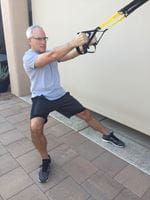
Objective: increase hip, knee, and ankle mobility
Adjust straps to medium length and stand facing the anchor. Grip the handles, widen your stance until you feel a slight stretch in your inner thighs, and sit back and away from the anchor until there’s no slack on the straps. Lunge side to side, keeping your toes and knees pointing slightly outward with your hips angled back. Stay lengthened in your entire spine, including in your cervical space.
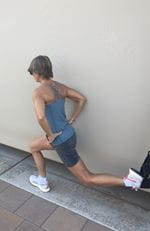 Balance Lunge
Balance Lunge
Objective: work balance while strengthening quads, hamstrings, and glutes
Lengthen straps to a mid-calf length and stand facing away from the anchor point. Slip the top of your left foot into the foot cradle. Hop out a few feet from wall and align your toes and knees straight ahead. Extend your left leg back as you bend your right leg and then draw the left forward, bending your knee until your thigh is close to perpendicular to the ground. To keep pressure off your front knee and your lower back, try not to lean too far forward—don’t advance past your front toe. After finishing your sets, switch legs.
This exercise requires good balance. To start, you might try holding onto the handles with no slack and facing away from the anchor while performing the leg movements. This offers much more stability.
Standing Arm Rotation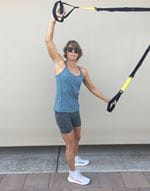
Objective: stretch and stabilize core and shoulder girdle to improve range of motion in shoulder joint
Adjust the straps to medium length and stand facing the anchor point. Grip handles and bend your knees slightly, with hips angled back. Open your right arm out and up to the right while maintaining tension on both of the straps and keeping your core engaged. Return to the center and then repeat on the left side. Continue alternating sides.
You can also perform a double-arm rotation. Push downward on both handles as you rotate right and raise your arms almost like you’re doing a golf swing. This requires more core engagement. Allow your feet to pivot and avoid arching your back—tucking your pelvis slightly during the “swing” can mitigate this. You can do a full set in one direction before changing sides or you can alternate sides within the set.
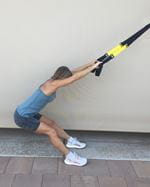 Hip Sink with Overhead Arm Raise
Hip Sink with Overhead Arm Raise
Objective: stretch lower back and lats and improve shoulder stability
Adjust the strap to the medium length and stand facing the anchor point. Grip handles and tip back away from anchor until there’s no slack left on the straps. Allow your hips to sink back and away from the anchor point and feel the spaces between your vertebrae expanding and your spinal muscles lengthening. Raise back up to near vertical by raising your arms overhead.
To further stretch your back, stand upright facing the anchor point and grip the handles, then walk back from the anchor until you can flatten your back forward, so your torso is nearly parallel to the ground. Slowly sink hips back away from the anchor to stretch. Hold for 30 to 60 seconds.
Chest Stretch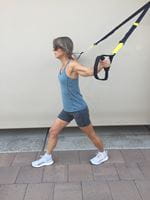
Objective: stretch pectoral muscles for good posture and optimal tissue and bone spacing for healthy movement in shoulder girdle
Adjust the straps so that the handles approximate the height of your shoulders. Stand facing away from the anchor point and grip handles with your arms extended and slightly in front of your shoulders. Step one foot forward with your front knee bent and back leg straight. Step and lean more forward until you feel a noticeable but comfortable stretch in your pectoral muscles. Avoid overstretching your internal rotators. Keep your shoulder blades retracted and gaze straight ahead, maintaining length in your neck. Hold for 30–60 seconds.
Try stretching your chest with the arms in a “W” position to alter the region of the pectorals being stretched.
Categories:
- Technique and Training
SIGN UP FOR UPDATES FROM USMS















